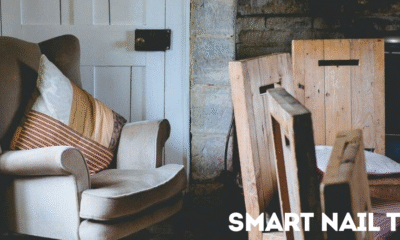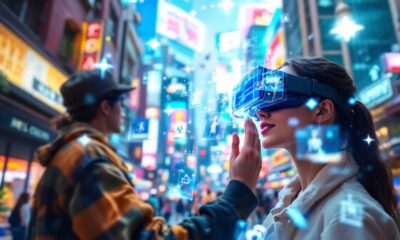Digital Marketing
Augmented Reality Shopping: What’s Next?

Augmented Reality (AR) shopping is changing the way we buy products, making the experience more interactive and enjoyable. This technology allows customers to visualise items in their own spaces or try them on virtually, bringing the store right to their homes. As AR continues to develop, it promises to reshape the retail landscape significantly. In this article, we will explore the evolution of AR shopping, the technologies driving it, and what the future holds for this exciting trend.
Key Takeaways
- AR shopping allows customers to try on clothes and visualise furniture in their homes without leaving their space.
- The technology is becoming more affordable, enabling small and large retailers to adopt AR experiences.
- AI integration with AR can create personalised shopping suggestions based on past purchases and preferences.
- AR enhances customer engagement, leading to higher sales and fewer returns for retailers.
- The future of AR in retail looks bright, with expectations for more immersive experiences and wider adoption.
The Evolution of Augmented Reality Shopping
Early Adoption and Trends
Augmented reality (AR) shopping has come a long way since its inception. Initially, it was a novelty, but it has quickly gained traction among consumers. Over 1.5 billion people now use AR regularly, with 100 million actively shopping through this technology. This growth was particularly noticeable during the pandemic, and projections suggest that by 2025, the number of AR users could reach 4.3 billion.
Technological Advancements
The rise of AR shopping is largely due to advancements in technology. Key developments include:
- Improved smartphone capabilities
- Enhanced 3D modelling techniques
- Faster internet speeds
These innovations have made it easier for consumers to engage with products in a virtual space, allowing them to see how items would look in their homes or on themselves.
Impact on Consumer Behaviour
The way consumers shop has changed dramatically with the introduction of AR. Shoppers can now:
- Virtually try on clothes and accessories.
- Visualise furniture in their own homes before making a purchase.
- Access detailed product information through interactive experiences.
The integration of AR in shopping has not only improved the experience but also increased conversion rates by 94%. This shows how effective AR can be in influencing purchasing decisions.
In summary, the evolution of AR shopping reflects a significant shift in consumer behaviour, driven by technological advancements and a growing acceptance of digital solutions in everyday life. As brands like vesture leather prepare to launch their AR shopping experiences, the future looks promising for this innovative retail approach.
Key Technologies Driving AR Shopping
Artificial Intelligence Integration
Artificial Intelligence (AI) plays a crucial role in enhancing the AR shopping experience. By analysing customer data, AI can provide personalised recommendations and improve product visualisation. This integration helps retailers understand consumer preferences better.
3D Modelling and Visualisation
3D modelling allows customers to see products in a realistic way before purchasing. This technology enables users to rotate, zoom, and interact with items, making online shopping more engaging.
Smartphone and Device Capabilities
With over 3.6 billion smartphones being AR-compatible, the accessibility of AR shopping is increasing. Most modern devices come equipped with AR capabilities, allowing users to experience augmented reality without needing additional software.
| Technology | Impact on AR Shopping |
|---|---|
| AI Integration | Personalised shopping |
| 3D Modelling | Enhanced product view |
| Device Compatibility | Wider user access |
The rise of AR technology is transforming how consumers shop, making it more interactive and enjoyable.
In summary, the combination of AI, 3D modelling, and advanced device capabilities is driving the future of AR shopping, making it a vital part of the retail landscape.
Virtual Try-Ons: Revolutionising Fashion Retail
How Virtual Try-Ons Work
Virtual try-ons use augmented reality technology to allow customers to see how clothes, shoes, or accessories would look on them without physically trying them on. This is done through smartphone cameras that overlay digital images onto the real world.
Benefits for Consumers and Retailers
- Convenience: Shoppers can try on multiple items from the comfort of their homes.
- Reduced Returns: By visualising how items will look, customers are less likely to return products, which can save retailers money.
- Enhanced Shopping Experience: The interactive nature of virtual try-ons makes shopping more engaging and fun.
Case Studies of Successful Implementations
| Brand | Implementation Type | Outcome |
|---|---|---|
| Nike | AR Shopping Lens on Snapchat | Increased engagement and sales |
| Sephora | Virtual Makeup Try-On | Higher customer satisfaction |
| IKEA | Furniture Visualisation | Reduced customer uncertainty |
Virtual try-ons are not just a trend; they are becoming a vital part of the shopping experience, helping both consumers and retailers navigate the evolving landscape of fashion retail.
AR in Home Furnishings and Decor
Visualising Furniture in Your Space
Augmented reality (AR) is changing how we shop for furniture. With augmented reality for the furniture industry, customers can see how a piece of furniture will look in their home before making a purchase. This technology allows users to place virtual furniture in their actual living spaces, helping them make better decisions.
Enhancing Interior Design with AR
AR not only helps in visualising furniture but also enhances the overall interior design process. Here are some benefits of using AR in home decor:
- Personalisation: Customers can customise furniture to match their existing decor.
- Reduced Returns: By visualising items in their space, customers are less likely to return products.
- Increased Confidence: Shoppers feel more assured about their choices, leading to higher satisfaction.
Popular Apps and Tools
Several apps are leading the way in AR for home furnishings:
- IKEA Place: This app uses LiDAR technology to measure rooms and suggest furniture.
- Wayfair: Users can take pictures of their homes and see matching furniture recommendations.
- Home Depot: Customers can view various items in their rooms, like appliances, before buying.
AR is revolutionising the way we shop for furniture, making it easier and more enjoyable for consumers. 61% of consumers prefer retailers with AR experiences, showing the growing demand for this technology in the market.
The Role of AR in E-Commerce
Augmented Reality (AR) is changing the way we shop online. It allows customers to see products in a new light, making the shopping experience more engaging and interactive. AR helps customers feel more confident in their purchases.
Boosting Online Sales
- Increased Engagement: AR features can keep customers on your site longer.
- Higher Conversion Rates: Shoppers who use AR are more likely to complete a purchase.
- Enhanced Product Understanding: Customers can see how products look in their own space before buying.
Reducing Return Rates
- Better Fit and Style: Virtual try-ons help customers choose the right size and style.
- Realistic Visualisation: Seeing how a product fits in their home reduces the chance of returns.
- Informed Decisions: Customers can make better choices with AR, leading to fewer regrets.
Enhancing Customer Engagement
- Interactive Experiences: AR creates fun and memorable shopping experiences.
- Personalised Shopping: Customers can customise products in real-time.
- Social Sharing: Shoppers can share their AR experiences with friends, increasing brand visibility.
AR is not just a trend; it’s becoming a vital part of the online shopping experience. Brands that embrace this technology can stand out in a crowded market.
In summary, AR is playing a crucial role in e-commerce by boosting sales, reducing returns, and enhancing customer engagement. As more brands adopt this technology, the shopping landscape will continue to evolve, making it essential for retailers to keep up with these changes.
Highlighted Example
For instance, the upcoming website for vesture leather is launching soon, focusing on gradual brand recognition through various media. Visitors are encouraged to subscribe for updates, showcasing the importance of staying connected with customers during this transition.
Challenges and Limitations of AR Shopping

Augmented Reality (AR) shopping is exciting, but it comes with its own set of challenges. Many businesses face obstacles that can hinder the full potential of AR in retail.
Technical Barriers
- Device Compatibility: Not all smartphones or tablets support AR features, limiting access for some consumers.
- Internet Connectivity: AR applications often require a strong internet connection, which can be a barrier in areas with poor service.
- Development Costs: Creating AR experiences can be expensive, especially for small businesses.
Consumer Privacy Concerns
- Data Security: Users may worry about how their data is collected and used by AR applications.
- Surveillance Fears: Some consumers feel uncomfortable with technology that tracks their movements or preferences.
- Trust Issues: Building trust is essential for consumers to feel safe using AR shopping tools.
Cost and Accessibility
- High Initial Investment: Setting up AR technology can be costly, making it hard for smaller retailers to compete.
- Limited User Base: Not everyone is familiar with AR, which can limit its adoption.
- Training Needs: Retail staff may require training to effectively use AR tools, adding to costs.
The future of AR shopping is bright, but overcoming these challenges is crucial for widespread adoption.
| Challenge | Description |
|---|---|
| Technical Barriers | Issues with device compatibility and internet connectivity. |
| Consumer Privacy Concerns | Worries about data security and surveillance. |
| Cost and Accessibility | High setup costs and limited user familiarity. |
Future Trends in Augmented Reality Shopping
Predictions for the Next Decade
The future of augmented reality (AR) shopping is bright and full of possibilities. As technology improves, we can expect AR experiences to become more immersive and realistic. Here are some predictions:
- More Interactive Experiences: Shoppers will be able to try on clothes that adapt to their movements.
- Wider Use of AR: Smaller retailers will start using AR as the technology becomes cheaper.
- AI Integration: AR will work with artificial intelligence to suggest products based on your style and preferences.
Innovations on the Horizon
Several exciting innovations are on the way:
- Enhanced Visualisation: Imagine seeing furniture with realistic textures and lighting in your home.
- Personalised Shopping: AR will tailor recommendations based on your past purchases and preferences.
- Social Shopping: Shoppers may share their AR experiences with friends in real-time.
Potential Market Growth
The AR shopping market is expected to grow significantly. Here’s a quick look at the projected growth:
| Year | Market Value (in billion USD) |
|---|---|
| 2022 | 40.12 |
| 2032 | 1.19 trillion |
The future of AR shopping is not just about technology; it’s about creating a more engaging and personalised shopping experience for everyone.
In conclusion, the integration of AR in shopping will change how we interact with products, making the experience more enjoyable and efficient. Keep an eye on these trends as they unfold!
Case Studies of Brands Using AR Shopping
Fashion and Beauty Brands
Several brands in the fashion and beauty sectors have embraced augmented reality (AR) to enhance the shopping experience. Nike has developed an app that allows users to virtually try on shoes, customising colours and styles before making a purchase. This interactive experience not only engages customers but also reduces return rates by ensuring a better fit.
Furniture and Home Improvement Stores
Wayfair is a notable example in the home furnishings sector. Their app enables users to visualise furniture in their own spaces, helping them make informed decisions. Similarly, Home Depot allows customers to see how appliances would look in their homes, making the shopping experience more immersive.
Consumer Electronics and Gadgets
Brands like Samsung have also ventured into AR shopping. They provide virtual demonstrations of their products, allowing customers to explore features and functionalities before buying. This approach not only boosts customer confidence but also enhances engagement.
| Brand | Industry | AR Feature Description |
|---|---|---|
| Nike | Fashion | Virtual try-on for shoes with customisation options |
| Wayfair | Home Furnishings | Visualisation of furniture in user’s space |
| Home Depot | Home Improvement | View appliances in home settings |
| Samsung | Consumer Electronics | Virtual product demonstrations |
The integration of AR in shopping is transforming how consumers interact with brands, making the experience more engaging and personalised.
Conclusion
These case studies illustrate how various brands are leveraging AR technology to enhance customer experiences. As AR continues to evolve, it is likely that more brands will adopt these innovative strategies to stay competitive in the market.
How to Implement AR in Your Retail Strategy
Choosing the Right Technology
To successfully integrate AR into your retail strategy, it’s crucial to select the right technology. Here are some key points to consider:
- Assess your needs: Determine what you want AR to achieve, such as enhancing customer experience or increasing sales.
- Research available options: Look into various AR platforms and tools that suit your business model.
- Consider user-friendliness: Ensure the technology is easy for both staff and customers to use.
Steps for Integration
Implementing AR can be a step-by-step process. Here’s a simple guide:
- Start small: Begin with a pilot project to test the waters.
- Gather feedback: Collect input from users to improve the experience.
- Scale up: Once successful, expand AR features across your retail channels.
Measuring Success and ROI
To understand the impact of AR on your business, it’s essential to measure its success. Consider these metrics:
- Customer engagement: Track how often customers interact with AR features.
- Sales conversion rates: Monitor any changes in sales before and after AR implementation.
- Customer satisfaction: Use surveys to gauge user experience and satisfaction levels.
Implementing AR in retail is not just about technology; it’s about enhancing the customer experience. By focusing on user needs, retailers can create a more engaging shopping journey.
In conclusion, AR can significantly transform retail strategies. By choosing the right technology, following a structured integration process, and measuring success, retailers can harness the power of AR to improve customer satisfaction and drive sales.
The Impact of AR on In-Store Shopping

AR Mirrors and Virtual Changing Rooms
AR technology is changing how we shop in physical stores. AR mirrors allow customers to try on clothes virtually, making the shopping experience more interactive. This technology helps shoppers see how items look without needing to change clothes.
Interactive Product Displays
With AR, product displays can come to life. Customers can point their devices at a product to see additional information, reviews, or even how the product fits into their lives. This enhances the shopping experience by providing more context and details about the products.
Blending Physical and Digital Experiences
AR creates a seamless blend of the physical and digital worlds. Shoppers can use their smartphones to scan items and receive tailored recommendations or promotions. This not only makes shopping more engaging but also helps retailers understand customer preferences better.
The impact of augmented reality is tremendous as it enhances customer engagement and saves time and costs, ultimately driving higher sales.
Key Benefits of AR in Stores
- Increased Engagement: Customers are more likely to spend time in stores that offer AR experiences.
- Higher Confidence: Shoppers feel more confident in their purchases when they can visualise products in their own space.
- Reduced Returns: By allowing customers to see how products fit their needs, AR can lead to fewer returns.
Summary Table of AR Benefits in Retail
| Benefit | Description |
|---|---|
| Increased Engagement | Shoppers spend more time in AR-enhanced stores. |
| Higher Confidence | Customers make informed decisions. |
| Reduced Returns | Fewer returns due to better product visualisation. |
Consumer Perceptions of AR Shopping
User Experience and Satisfaction
Many consumers find augmented reality (AR) shopping to be an exciting and engaging experience. It allows them to interact with products in a way that traditional shopping cannot. Here are some key points about user satisfaction:
- Enhanced Engagement: AR makes shopping more interactive, leading to higher engagement levels.
- Informed Decisions: Customers feel more confident in their purchases when they can see how products will look in their own space.
- Fun Factor: The novelty of AR adds an element of fun to shopping, making it more enjoyable.
Adoption Rates and Demographics
The adoption of AR shopping is growing rapidly. Recent studies show that:
- 51% of smartphone users have tried AR shopping in 2024.
- 75% of consumers aged 16-44 are aware of AR technology.
- 66% of consumers in Japan want AR experiences in physical stores.
Feedback and Reviews
Consumer feedback on AR shopping is generally positive. Many appreciate the convenience and the ability to customise their shopping experience. Here’s a summary of consumer sentiments:
- Positive Reviews: Many users report high satisfaction rates, with 73% of mobile AR users expressing enjoyment.
- Willingness to Pay More: 40% of consumers say they would pay extra for products they can customise using AR.
- Increased Shopping Frequency: 71% of consumers would shop more often if AR was available.
AR shopping is not just a trend; it’s reshaping how consumers interact with products, leading to increased satisfaction and loyalty.
Overall, AR shopping is changing consumer perceptions, making shopping more engaging and personalised. As technology continues to evolve, we can expect even greater integration of AR into the shopping experience.
The Economic Impact of AR Shopping
Increased Sales and Revenue
Augmented Reality (AR) shopping is changing the way consumers buy products, leading to higher sales for retailers. Here are some key points:
- Conversion Rates: Brands using AR see conversion rates increase by up to 94%.
- Customer Willingness to Pay: 40% of consumers are willing to pay more for products they can customise in AR.
- Market Growth: The AR market is projected to reach $10.9 billion in the U.S. this year.
Job Creation and Skills Demand
As AR shopping grows, so does the need for skilled workers. This includes:
- AR Developers: Professionals who create AR applications.
- Digital Marketers: Experts who promote AR products.
- Customer Support: Staff trained to assist customers using AR technology.
Investment Opportunities
Investing in AR technology can lead to significant returns. Companies are:
- Exploring new AR applications.
- Partnering with tech firms to enhance their offerings.
- Seeking funding to develop innovative AR solutions.
The rise of AR shopping is not just a trend; it’s a transformative shift in how consumers interact with products, leading to a more engaging shopping experience.
In summary, AR shopping is not only boosting sales but also creating jobs and opening up new investment avenues. As more brands adopt this technology, the economic impact will continue to grow, reshaping the retail landscape.
Conclusion
In conclusion, augmented reality (AR) shopping is set to change the way we buy things in the future. As technology improves, we can expect even better AR experiences that feel real and engaging. Imagine being able to try on clothes or see how a new sofa would look in your living room without leaving your home. More shops, big and small, will start using AR as it becomes cheaper and easier to access. Plus, when AR works together with artificial intelligence, it can suggest items that fit your style perfectly. This means shopping will be more personal and enjoyable than ever before. So, next time you shop, keep an eye out for AR features—they could make your shopping experience smarter and more fun!
Frequently Asked Questions
What is augmented reality shopping?
Augmented reality shopping lets you try on clothes or see how furniture looks in your home using your phone or tablet. It adds digital images to the real world you see.
How does augmented reality change the shopping experience?
With augmented reality, you can see how items look on you or in your space before buying, making shopping easier and more fun.
Is augmented reality shopping popular?
Yes! More and more people are using augmented reality to shop. It’s becoming a common way to buy clothes, furniture, and more.
What are the benefits of using augmented reality in shopping?
Augmented reality helps you make better choices by letting you see how products will look. This can reduce returns and improve satisfaction.
Can I use augmented reality shopping on my phone?
Absolutely! Most augmented reality shopping experiences work on smartphones and tablets, making it easy to use anywhere.
Are there any downsides to augmented reality shopping?
Some challenges include needing good internet, privacy concerns, and the cost of technology, which can be high for some retailers.
What does the future hold for augmented reality shopping?
The future looks bright! As technology improves, we can expect even more interactive and personalised shopping experiences.
Which brands are using augmented reality shopping?
Many brands are using augmented reality, especially in fashion, beauty, and home goods. Companies like Nike and Wayfair are leading the way.
-

 Art & Culture7 days ago
Art & Culture7 days agoThe Ultimate Guide to Nails Hollywood: Trends, Styles, and Top Salons in 2025
-

 Education7 days ago
Education7 days agoUnlocking Knowledge: How the Udemy App Transforms Online Learning
-

 Business7 days ago
Business7 days agoIs the Housing Market Going to Crash in 2025? Insights and Predictions Ahead
-

 Business7 days ago
Business7 days agoDow Futures Surge as Trump Postpones EU Tariffs
-

 Health & Fitness7 days ago
Health & Fitness7 days agoDiscover the Best Hair Skin and Nail Pills for Radiant Beauty in 2025
-

 Space7 days ago
Space7 days agoExploring the Latest Discoveries of the James Webb Telescope on Reddit
-

 Stock Market5 days ago
Stock Market5 days agoUS Stocks Soar as Court Blocks Trump Tariffs and Nvidia Delivers Strong Earnings
-

 Government7 days ago
Government7 days agoUnderstanding the Federal Judiciary: How Many Circuit Courts Are There in the United States?


























